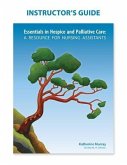Rural Nursing, Sixth Edition
Concepts, Theory, and Practice
Herausgeber: Winters, Charlene A
Schade – dieser Artikel ist leider ausverkauft. Sobald wir wissen, ob und wann der Artikel wieder verfügbar ist, informieren wir Sie an dieser Stelle.
Rural Nursing, Sixth Edition
Concepts, Theory, and Practice
Herausgeber: Winters, Charlene A
- Broschiertes Buch
- Merkliste
- Auf die Merkliste
- Bewerten Bewerten
- Teilen
- Produkt teilen
- Produkterinnerung
- Produkterinnerung
This book "remains the only text to provide a wide range of essential information for nurses who work in sparsely populated and vulnerable geographical areas. Focusing on rural nursing concepts, theory, research, education, public health, and healthcare delivery from a national and international perspective, the sixth edition is distinguished by its emphasis on practical applications. With ten completely new chapters and substantial revisions, it disseminates the skills and knowledge required for effective nursing practice, education, and research regarding the evolving rural and frontier setting"--Publisher marketing.…mehr
Andere Kunden interessierten sich auch für
![Fast Facts for the School Nurse Fast Facts for the School Nurse]() Janice Ma LoschiavoFast Facts for the School Nurse41,99 €
Janice Ma LoschiavoFast Facts for the School Nurse41,99 €![Wound Care Pocket Guide Wound Care Pocket Guide]() Wound Care Pocket Guide12,99 €
Wound Care Pocket Guide12,99 €![Capstone Coach for Nursing Excellence Capstone Coach for Nursing Excellence]() Linda CampbellCapstone Coach for Nursing Excellence62,99 €
Linda CampbellCapstone Coach for Nursing Excellence62,99 €![Instructor's Guide: Essentials in Hospice and Palliative Care Instructor's Guide: Essentials in Hospice and Palliative Care]() Katherine MurrayInstructor's Guide: Essentials in Hospice and Palliative Care27,99 €
Katherine MurrayInstructor's Guide: Essentials in Hospice and Palliative Care27,99 €![A Caregiver's Guide to Wound Care A Caregiver's Guide to Wound Care]() Jennifer J. Taylor MDA Caregiver's Guide to Wound Care31,99 €
Jennifer J. Taylor MDA Caregiver's Guide to Wound Care31,99 €![The Inside Truth About Nursing Homes The Inside Truth About Nursing Homes]() Clara BrownThe Inside Truth About Nursing Homes13,99 €
Clara BrownThe Inside Truth About Nursing Homes13,99 €![Gerontological Nurse Certification Review, Third Edition Gerontological Nurse Certification Review, Third Edition]() Alison E KrisGerontological Nurse Certification Review, Third Edition81,99 €
Alison E KrisGerontological Nurse Certification Review, Third Edition81,99 €-
-
-
This book "remains the only text to provide a wide range of essential information for nurses who work in sparsely populated and vulnerable geographical areas. Focusing on rural nursing concepts, theory, research, education, public health, and healthcare delivery from a national and international perspective, the sixth edition is distinguished by its emphasis on practical applications. With ten completely new chapters and substantial revisions, it disseminates the skills and knowledge required for effective nursing practice, education, and research regarding the evolving rural and frontier setting"--Publisher marketing.
Produktdetails
- Produktdetails
- Verlag: Springer Publishing Company
- 6th edition
- Seitenzahl: 456
- Erscheinungstermin: 16. September 2021
- Englisch
- Abmessung: 254mm x 178mm x 22mm
- Gewicht: 721g
- ISBN-13: 9780826183637
- ISBN-10: 0826183638
- Artikelnr.: 62605857
- Herstellerkennzeichnung
- Libri GmbH
- Europaallee 1
- 36244 Bad Hersfeld
- gpsr@libri.de
- Verlag: Springer Publishing Company
- 6th edition
- Seitenzahl: 456
- Erscheinungstermin: 16. September 2021
- Englisch
- Abmessung: 254mm x 178mm x 22mm
- Gewicht: 721g
- ISBN-13: 9780826183637
- ISBN-10: 0826183638
- Artikelnr.: 62605857
- Herstellerkennzeichnung
- Libri GmbH
- Europaallee 1
- 36244 Bad Hersfeld
- gpsr@libri.de
Section 1: Rural Nursing Theory & Research
Chapter 1: Rural Nursing: Past, Present & Future
Chapter 2: Rural Nursing: Developing the Theory Base
Chapter 3: Concept Analysis
Chapter 4: Updating the Rural Nursing Theory Base
Chapter 5: Lack of Anonymity: Changes for the 21st Century
Chapter 6: Rural Nursing Theory and Research on the Frontier
Chapter 7: Program of research in Rural settings
Section 2: Rural Nursing Practice
Chapter 8: The Distinctive Nature and Scope of Rural Nursing Practice:
Philosophical Bases
Chapter 9: Understanding the Lived Experiences of the Rural Bedside Nurse:
A Global View
Chapter 10: Experiences of Nurses Living in Rural Communities Who Commute
for Employment
Chapter 11: The Nurse Practitioner as Rural Health Care Provider
Chapter 12: Using RNs in Primary Care: Opportunities and Challenges for
Rural Clinics
Section 3: Healthcare Delivery in Rural and Frontier Settings
Chapter 13: Beyond the Symptom-Action-Timeline Process: Explicating the
Health-Needs-Action Process
Chapter 14: Acceptability: One Component in Choice of Health Care Provider
Chapter 15: Telehealth in Rural Nursing Practice
Chapter 16: Emergency Medical Services (EMS) on the Frontier
Chapter 17: Palliative Care for the Rural Chronically Ill
Chapter 18: Challenges and Opportunities to Palliative Care for Rural
Veterans
Chapter 19: Rural Youth Suicide Risk Assessment and Intervention for Rural
Healthcare Providers and Families
Chapter 20: Improving Health Literacy About Complementary and Alternative
Therapy Among Rural Dwellers
Section 4: Nursing Education
Chapter 21: Implications for Education, Practice, and Policy
Chapter 22: Clinical Placements in Rural Hospitals: Expanding Nursing
Students’ Knowledge, Skills, and Attitudes toward Rural Healthcare
Chapter 23: Where You Live Matters: Bringing Interprofessional Education to
the Rural Healthcare Workforce
Chapter 24: Explicating Family Nurse Practitioner Competencies for Rural
Practice
Chapter 25: Development and Psychometric Evaluation of the Rural Knowledge
Scale
Chapter 26: Developing and Sustaining the Rural Nursing Workforce Through
Collaborative
Educational Models
Chapter 27: Transcultural Service-Learning: Preparing Nurses to Meet the
Needs of Rural Indigenous Communities
Section 5: Vulnerable Populations
Chapter 28: Risks to Safety and Health for Migrant and Seasonal Farmworkers
Chapter 29: American Indian Perspectives on Palliative and End-of-Life Care
Chapter 30: An Evidence-Based Policy and Educational Program for Neonates
Experiencing Opioid Withdrawal
Chapter 31: The Rural Participatory Research Model (RPRM)
Chapter 1: Rural Nursing: Past, Present & Future
Chapter 2: Rural Nursing: Developing the Theory Base
Chapter 3: Concept Analysis
Chapter 4: Updating the Rural Nursing Theory Base
Chapter 5: Lack of Anonymity: Changes for the 21st Century
Chapter 6: Rural Nursing Theory and Research on the Frontier
Chapter 7: Program of research in Rural settings
Section 2: Rural Nursing Practice
Chapter 8: The Distinctive Nature and Scope of Rural Nursing Practice:
Philosophical Bases
Chapter 9: Understanding the Lived Experiences of the Rural Bedside Nurse:
A Global View
Chapter 10: Experiences of Nurses Living in Rural Communities Who Commute
for Employment
Chapter 11: The Nurse Practitioner as Rural Health Care Provider
Chapter 12: Using RNs in Primary Care: Opportunities and Challenges for
Rural Clinics
Section 3: Healthcare Delivery in Rural and Frontier Settings
Chapter 13: Beyond the Symptom-Action-Timeline Process: Explicating the
Health-Needs-Action Process
Chapter 14: Acceptability: One Component in Choice of Health Care Provider
Chapter 15: Telehealth in Rural Nursing Practice
Chapter 16: Emergency Medical Services (EMS) on the Frontier
Chapter 17: Palliative Care for the Rural Chronically Ill
Chapter 18: Challenges and Opportunities to Palliative Care for Rural
Veterans
Chapter 19: Rural Youth Suicide Risk Assessment and Intervention for Rural
Healthcare Providers and Families
Chapter 20: Improving Health Literacy About Complementary and Alternative
Therapy Among Rural Dwellers
Section 4: Nursing Education
Chapter 21: Implications for Education, Practice, and Policy
Chapter 22: Clinical Placements in Rural Hospitals: Expanding Nursing
Students’ Knowledge, Skills, and Attitudes toward Rural Healthcare
Chapter 23: Where You Live Matters: Bringing Interprofessional Education to
the Rural Healthcare Workforce
Chapter 24: Explicating Family Nurse Practitioner Competencies for Rural
Practice
Chapter 25: Development and Psychometric Evaluation of the Rural Knowledge
Scale
Chapter 26: Developing and Sustaining the Rural Nursing Workforce Through
Collaborative
Educational Models
Chapter 27: Transcultural Service-Learning: Preparing Nurses to Meet the
Needs of Rural Indigenous Communities
Section 5: Vulnerable Populations
Chapter 28: Risks to Safety and Health for Migrant and Seasonal Farmworkers
Chapter 29: American Indian Perspectives on Palliative and End-of-Life Care
Chapter 30: An Evidence-Based Policy and Educational Program for Neonates
Experiencing Opioid Withdrawal
Chapter 31: The Rural Participatory Research Model (RPRM)
Section 1: Rural Nursing Theory & Research
Chapter 1: Rural Nursing: Past, Present & Future
Chapter 2: Rural Nursing: Developing the Theory Base
Chapter 3: Concept Analysis
Chapter 4: Updating the Rural Nursing Theory Base
Chapter 5: Lack of Anonymity: Changes for the 21st Century
Chapter 6: Rural Nursing Theory and Research on the Frontier
Chapter 7: Program of research in Rural settings
Section 2: Rural Nursing Practice
Chapter 8: The Distinctive Nature and Scope of Rural Nursing Practice:
Philosophical Bases
Chapter 9: Understanding the Lived Experiences of the Rural Bedside Nurse:
A Global View
Chapter 10: Experiences of Nurses Living in Rural Communities Who Commute
for Employment
Chapter 11: The Nurse Practitioner as Rural Health Care Provider
Chapter 12: Using RNs in Primary Care: Opportunities and Challenges for
Rural Clinics
Section 3: Healthcare Delivery in Rural and Frontier Settings
Chapter 13: Beyond the Symptom-Action-Timeline Process: Explicating the
Health-Needs-Action Process
Chapter 14: Acceptability: One Component in Choice of Health Care Provider
Chapter 15: Telehealth in Rural Nursing Practice
Chapter 16: Emergency Medical Services (EMS) on the Frontier
Chapter 17: Palliative Care for the Rural Chronically Ill
Chapter 18: Challenges and Opportunities to Palliative Care for Rural
Veterans
Chapter 19: Rural Youth Suicide Risk Assessment and Intervention for Rural
Healthcare Providers and Families
Chapter 20: Improving Health Literacy About Complementary and Alternative
Therapy Among Rural Dwellers
Section 4: Nursing Education
Chapter 21: Implications for Education, Practice, and Policy
Chapter 22: Clinical Placements in Rural Hospitals: Expanding Nursing
Students’ Knowledge, Skills, and Attitudes toward Rural Healthcare
Chapter 23: Where You Live Matters: Bringing Interprofessional Education to
the Rural Healthcare Workforce
Chapter 24: Explicating Family Nurse Practitioner Competencies for Rural
Practice
Chapter 25: Development and Psychometric Evaluation of the Rural Knowledge
Scale
Chapter 26: Developing and Sustaining the Rural Nursing Workforce Through
Collaborative
Educational Models
Chapter 27: Transcultural Service-Learning: Preparing Nurses to Meet the
Needs of Rural Indigenous Communities
Section 5: Vulnerable Populations
Chapter 28: Risks to Safety and Health for Migrant and Seasonal Farmworkers
Chapter 29: American Indian Perspectives on Palliative and End-of-Life Care
Chapter 30: An Evidence-Based Policy and Educational Program for Neonates
Experiencing Opioid Withdrawal
Chapter 31: The Rural Participatory Research Model (RPRM)
Chapter 1: Rural Nursing: Past, Present & Future
Chapter 2: Rural Nursing: Developing the Theory Base
Chapter 3: Concept Analysis
Chapter 4: Updating the Rural Nursing Theory Base
Chapter 5: Lack of Anonymity: Changes for the 21st Century
Chapter 6: Rural Nursing Theory and Research on the Frontier
Chapter 7: Program of research in Rural settings
Section 2: Rural Nursing Practice
Chapter 8: The Distinctive Nature and Scope of Rural Nursing Practice:
Philosophical Bases
Chapter 9: Understanding the Lived Experiences of the Rural Bedside Nurse:
A Global View
Chapter 10: Experiences of Nurses Living in Rural Communities Who Commute
for Employment
Chapter 11: The Nurse Practitioner as Rural Health Care Provider
Chapter 12: Using RNs in Primary Care: Opportunities and Challenges for
Rural Clinics
Section 3: Healthcare Delivery in Rural and Frontier Settings
Chapter 13: Beyond the Symptom-Action-Timeline Process: Explicating the
Health-Needs-Action Process
Chapter 14: Acceptability: One Component in Choice of Health Care Provider
Chapter 15: Telehealth in Rural Nursing Practice
Chapter 16: Emergency Medical Services (EMS) on the Frontier
Chapter 17: Palliative Care for the Rural Chronically Ill
Chapter 18: Challenges and Opportunities to Palliative Care for Rural
Veterans
Chapter 19: Rural Youth Suicide Risk Assessment and Intervention for Rural
Healthcare Providers and Families
Chapter 20: Improving Health Literacy About Complementary and Alternative
Therapy Among Rural Dwellers
Section 4: Nursing Education
Chapter 21: Implications for Education, Practice, and Policy
Chapter 22: Clinical Placements in Rural Hospitals: Expanding Nursing
Students’ Knowledge, Skills, and Attitudes toward Rural Healthcare
Chapter 23: Where You Live Matters: Bringing Interprofessional Education to
the Rural Healthcare Workforce
Chapter 24: Explicating Family Nurse Practitioner Competencies for Rural
Practice
Chapter 25: Development and Psychometric Evaluation of the Rural Knowledge
Scale
Chapter 26: Developing and Sustaining the Rural Nursing Workforce Through
Collaborative
Educational Models
Chapter 27: Transcultural Service-Learning: Preparing Nurses to Meet the
Needs of Rural Indigenous Communities
Section 5: Vulnerable Populations
Chapter 28: Risks to Safety and Health for Migrant and Seasonal Farmworkers
Chapter 29: American Indian Perspectives on Palliative and End-of-Life Care
Chapter 30: An Evidence-Based Policy and Educational Program for Neonates
Experiencing Opioid Withdrawal
Chapter 31: The Rural Participatory Research Model (RPRM)









